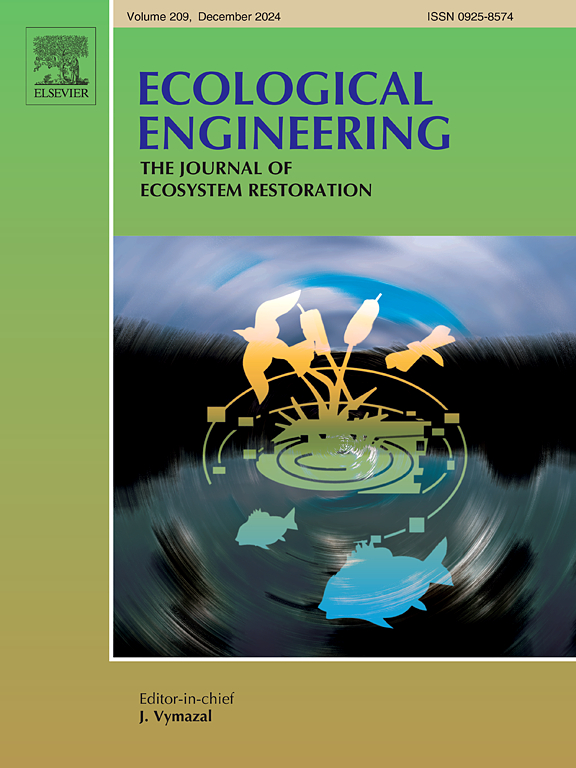The role of Gala Lake Wetland Site on flood control
IF 4.1
2区 环境科学与生态学
Q1 ECOLOGY
引用次数: 0
Abstract
The negative impacts of climate change and rapid urbanization have led to an increase in flood events globally. Wetlands, as best management practices, play a key role in reducing flood peaks and improving water quality. Despite their significance, many natural wetland sites remain understudied, including the Gala Lake Wetland Site in Edirne, Türkiye, an important biodiversity area providing food and clean water, protecting communities from floods, and mitigating climate change impacts. This study presents a comprehensive and integrated hydrological modeling approach to assess the flood control function of the Gala Lake Wetland by coupling the Soil and Water Assessment Tool (SWAT) and the Environmental Protection Agency's Storm Water Management Model (EPA SWMM) supported with field observations. This integrated modeling framework contributes to the understanding of the hydrological behavior of basin-lake-wetland system by combining basin-scale rainfall-runoff simulation with detailed hydrological analysis of wetland site at the subbasin level, and by showing the EPA SWMM capability in representing wetland site characteristics and simulating wetland hydrology. First, a site investigation of the wetland site was conducted to support model development. Then, SWAT was employed to simulate the hydrological response of the Gala Lake Watershed. Subsequently, a detailed hydrological model of the subbasin involving the wetland-lake system was generated using EPA SWMM and incorporating field observations. The SWAT-simulated outflow was used as the inflow boundary condition for the EPA SWMM model, enabling a comprehensive evaluation of the wetland's flood attenuation performance. Results demonstrate that the Gala Lake Wetland significantly reduces peak flows by up to 90 % emphasizing its critical role in natural flood mitigation. This study contributes to the limited research on the Gala Lake Wetland and proposes a holistic approach for wetland flood control assessments.
加拉湖湿地遗址在防洪中的作用
气候变化和快速城市化的负面影响导致全球洪水事件增加。湿地作为最佳管理措施,在减少洪峰和改善水质方面发挥着关键作用。尽管具有重要意义,但许多天然湿地仍未得到充分研究,包括位于 rkiye省Edirne的加拉湖湿地,这是一个重要的生物多样性区域,提供食物和清洁水,保护社区免受洪水侵袭,并缓解气候变化的影响。本研究提出了一种综合水文模拟方法,通过耦合土壤和水分评估工具(SWAT)和环境保护署(EPA)的雨水管理模型(SWMM),并结合野外观测,来评估嘎拉湖湿地的防洪功能。该综合建模框架通过将流域尺度的降雨径流模拟与次流域层面湿地场地的详细水文分析相结合,展示EPA SWMM在表征湿地场地特征和模拟湿地水文方面的能力,有助于理解流域-湖泊-湿地系统的水文行为。首先,对湿地进行了现场调查,以支持模型的开发。利用SWAT模拟了嘎拉湖流域的水文响应。随后,利用EPA SWMM并结合野外观测,生成了涉及湿地-湖泊系统的子流域详细水文模型。EPA SWMM模型采用swat模拟的流出量作为流入边界条件,对湿地的洪水衰减性能进行综合评价。结果表明,加拉湖湿地可显著减少洪峰流量达90%,凸显了其在自然洪水缓解中的关键作用。本研究弥补了加拉湖湿地研究的不足,为湿地防洪评价提供了一种整体方法。
本文章由计算机程序翻译,如有差异,请以英文原文为准。
求助全文
约1分钟内获得全文
求助全文
来源期刊

Ecological Engineering
环境科学-工程:环境
CiteScore
8.00
自引率
5.30%
发文量
293
审稿时长
57 days
期刊介绍:
Ecological engineering has been defined as the design of ecosystems for the mutual benefit of humans and nature. The journal is meant for ecologists who, because of their research interests or occupation, are involved in designing, monitoring, or restoring ecosystems, and can serve as a bridge between ecologists and engineers.
Specific topics covered in the journal include: habitat reconstruction; ecotechnology; synthetic ecology; bioengineering; restoration ecology; ecology conservation; ecosystem rehabilitation; stream and river restoration; reclamation ecology; non-renewable resource conservation. Descriptions of specific applications of ecological engineering are acceptable only when situated within context of adding novelty to current research and emphasizing ecosystem restoration. We do not accept purely descriptive reports on ecosystem structures (such as vegetation surveys), purely physical assessment of materials that can be used for ecological restoration, small-model studies carried out in the laboratory or greenhouse with artificial (waste)water or crop studies, or case studies on conventional wastewater treatment and eutrophication that do not offer an ecosystem restoration approach within the paper.
 求助内容:
求助内容: 应助结果提醒方式:
应助结果提醒方式:


